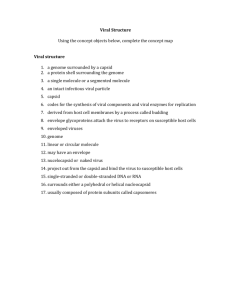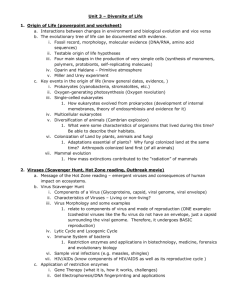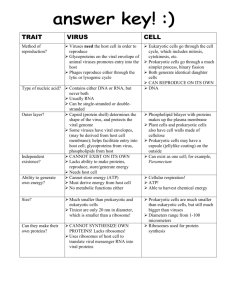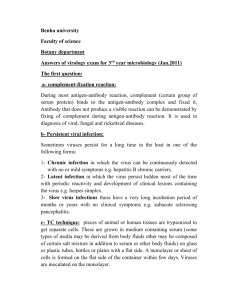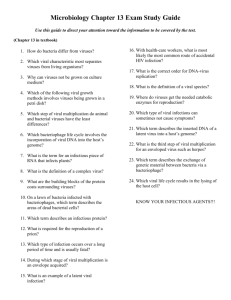Viruses
advertisement
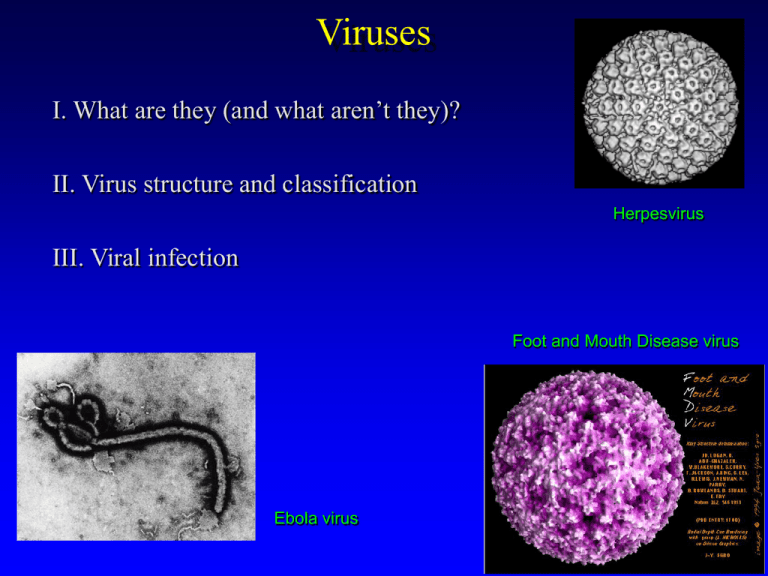
Viruses I. What are they (and what aren’t they)? II. Virus structure and classification Herpesvirus III. Viral infection Foot and Mouth Disease virus Ebola virus Characteristics of Viruses Somewhere between life and non-life Bacteriophage Phi X 174 Can’t reproduce or __________________ independently But can direct living cells to do so for them “___________________ intracellular parasites” “Infectious particles” rather than “organisms”, “active” or “inactive” rather than “alive” or “dead”. General Structure Nucleocapsid • Small -- _______________ nm DNA or RNA in diameter • All have nucleocapsid composed of ______________ and nucleic acid • Capsid Enveloped virus Some have a phospholipid bilayer membrane (envelope) Envelope Spike Viral envelope • Common in animal and plant viruses • Membrane is required for ______________ • Viral envelopes are actually portions of the infected host cell _____________________ (viruses do not form their own) • Often replace ______________ proteins with viral glycoproteins Nucleocapsid architecture Two most common shapes: helical & icosahedral. Both are regular, geometric shapes determined by the structure and orientation of proteins in the ________________________ Helical structure Virus _________ Capsomeres (___________ building blocks) Helical structure: Tobacco Mosaic Virus TMV is composed of only_________ types of molecules: a single ________ molecule and one type of protein Icosahedral structure Composed of only one or two different proteins + nucleic acid Note that in both of these architectures, only one or two types of proteins used. Means that the virus needs only one or two protein-coding ________________. Adenoviruses -- non-enveloped icosahedral viruses which are generally mild pathogens in humans, birds, etc. causing ___________________ (‘pink eye’) and _________________ illnesses. Complex viruses A number of types with somewhat more ___________ structures One is typical bacteriophage, with icosahedral head, helical tail, fibers for attachment Bacteriophage lambda Nucleic acid content Viral genomes are very small ___________ base pairs (enough to encode 3 or 4 proteins) to 200,000 bp compared to bacteria (~106 bp) and human (~2 X 109 bp). Small Characterized by __________________ genes Viral genomic DNA mRNA transcripts (overlapping) Viral genomes. The genomes of viruses can be either _________ or ________ (or some use both at different stages in their life cycle) E. coli bacteriophages Viral classification Viral classification (cont.) Viral Infection -- Overview 1) Adsorption 2) ____________ (either of nucleocapsid or of nucleic acid only) 3a) Viral _______________ (lytic phase) or 3b) Integration of viral genome into host cell genome (lysogenic phase) 4) Exit from cell Adsorption Specific interaction of viral surface with cell surface. This is the reason viruses only infect certain cell types, for example: HIV only infects cells (such as T cells) with the CD4 glycoprotein on their surface. Influenza virus (an orthomyxovirus) only infects mucosal cells of upper ____________________ tract. Bacteriophages are highly ___________________ for certain hosts (e.g. coliphages only infect E. coli) Entry 1) ______________ of nucleic acid (e.g. T4 phage) 2) Entry of ___________ nucleocapsid (most common in animal and plant viruses) Cell membrane Endocytosis: Virus in vescicle Vesicle and capsid break down, releasing nucleic acid Membrane ____________ (only in enveloped viruses) Out Cell membrane In Out In Out In Out In Viral replication • Once inside, one of several things occurs, depending on the virus. • However, the end result is always ________ ________________ • Involves: 1) Replication of the nucleic acid 2) Synthesis of capsid proteins 3) ________________ of nucleocapsids General stages of (lytic) virus replication One-step growth curve of virus replication Lysogeny or ‘integration’ vs. lytic pathways Exit • • Cell lysis or Budding HIV movie QuickTime™ and a Cinepak decompressor are needed to see this picture.

